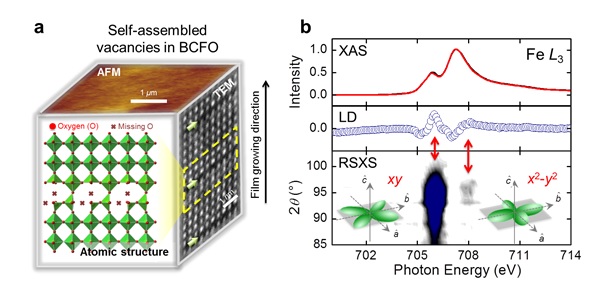In all oxide compounds, oxygen vacancies intrinsically exist and their role and impact on materials’ properties have been studied for several decades. Mostly they have been considered as defects that disturb a ‘perfect world’. Nowadays, however, researchers consider them as new parameters for controlling functionalities of oxide compounds such as quantum and energy materials; here, the multiferroic ferrite, BiFeO3, is presented as a remarkable example. In this context, BiFeO3 has been extensively studied for its electromagnetic properties,1 in which magnetic order (antiferromagnetism) and electric polarization (ferroelectricity) are coupled and inter-controllable. The combination of two or more controllable parameters is considered a route to realizing new kinds of devices. Moreover, a switchable photovoltaic effect and its diode effect have been demonstrated.2 In BiFeO3, the mechanism of the photovoltaic effect has been found to be a migration of positively charged oxygen vacancies manipulated via an external electric field. Therefore, it has been simply assumed that the photovoltaic and diode effects are changed by the oxygen vacancy content and supposed to be enhanced by an increasing oxygen content.
Unfortunately, bringing such photovoltaic functionality to practical application is still unlikely. For example, when Bi3+ ions are substituted by divalent ions, like Ca2+, additional oxygen vacancies are formed, and the corresponding photovoltaic effect is supposed to increase according to the assumed mechanism. However, the functionality breaks down3 if the substitution rate increases to >15 %. This indicates that the oxygen vacancies in this photovoltaic system are strongly correlated with the photovoltaic functionality. However, it is still early stages of developing a detailed understanding of the mechanism. This is because the role of oxygen vacancies in photovoltaic systems has been discussed only conceptually. In particular, one of the reasons of the poor understanding is that the oxygen vacancies are extremely difficult to detect through conventional spectroscopic techniques. Hence, detecting the role of oxygen vacancies in photovoltaics is still challenging.

Figure 1. (a) Conceptual picture describing the self-assembled oxygen vacancy structure in a BCFO film (b) XAS / LD / RSXS results measured in the Fe L3-edge region. The inset illustrates the Fe 3d orbital band reconstructed via the oxygen vacancies.
To detect the specific microscopic feature of the oxygen vacancies on Ca-doped BiFeO3 films (hereafter BCFO), the authors performed resonant soft x-ray scattering (RSXS) measurements as well as polarized x-ray absorption spectroscopy (XAS) experiments.5 Typically, oxygen vacancies are randomly distributed in this kind of a system. For BCFO, oxygen vacancies form self-assembled periodic layers with a Brownmillerite-like structure perpendicular to the film growth direction, i.e. [001] direction of the SrTiO3 substrate, as shown in Fig. 1a.4 This periodic formation enabled the investigators to explore the site-selective electronic structure through RSXS measurements, performed at SSRL’s BL13-3, using the recently developed RSXS capability. Experimental details are available in Ref. 6. First, the valence Fe 3d electronic structure as a function of the oxygen vacancies was investigated, by using polarization dependent XAS at the Fe L-edge (Fig. 1b), using the linear dichroism (LD) properties of the system. In addition, the LD spectrum was compared to that generated using atomic multiplet calculations. From this comparison, a remarkable deviation was found, where the energy positions seem to be associated with the in-plane Fe 3d orbital characters, such as xy and x2-y2. However, it is still unclear whether the deviation is from an entire systems change, or whether it is only due to the oxygen vacancy effect. This indicates that the Fe 3d orbital states are modified by the oxygen vacancies. In order to clearly elucidate how the oxygen vacancies modify the Fe 3d orbitals, RSXS measurement were performed at the Fe L-edge. Its resonant profile is very different from the XAS spectral shape, indicating that the Fe octahedral symmetry is transformed to either tetrahedral or square pyramidal symmetry under existing oxygen vacancies at the interfaces. Finally, from the polarization dependence of the (002) reflection, which originates from the oxygen vacancies, it was clearly found that the deviations in the LD results are attributed to the Fe 3d xy (t2g) and x2-y2 (eg) orbital bands modified by the oxygen vacancies.
In summary, XAS and RSXS results clearly demonstrate that local in-plane Fe orbital bands are formed and reconstructed by oxygen vacancies with structural deformation in the Ca-doped BiFeO3 film. Thereby, a disturbance of the electron hopping alters the electronic properties of the material. In this manner, these results provide a key insight into the changes of the photovoltaic and diode effects in BiFeO3 that occur with the change in the oxygen vacancy content. As a consequence, it would be expected that the study of the microscopic aspects of oxygen vacancies are not only restricted to specific systems, but can also widely applied to the study of different energy materials and general oxide systems.
- J.-C. Yang et al., “BiFeO3 Thin Films: A Playground for Exploring Electric-Field Control of Multifunctionalities”, Annu. Rev. Mater. Res. 45, 249 (2015). DOI: 10.1146/annurev-matsci-070214-020837.
- T. Choi et al., “Switchable Ferroelectric Diode and Photovoltaic Effect in BiFeO3”, Science 324, 63 (2009), DOI: 10.1126/science.1168636.
- C. S. Tu et al., “Calcium-doping Effects on Photovoltaic Response and Structure in Multiferroic BiFeO3 Ceramics”, J. Appl. Phys. 114, 124105 (2013), DOI: 10.1063/1.4823856.
- C.-H. Yang et al., “Electric Modulation of Conduction in Multiferroic Ca-doped BiFeO3 Films”, Nat. Mater. 8, 485 (2009), DOI: 10.1038/nmat2432.
- Note that the conventional XAS measurement is hard to distinguish a spatial distribution of the vacancy effect in spite of a substantial amount of oxygen vacancies. Since the RSXS technique is sensitive to both site and electronic, the oxygen vacancy’s effect under the site selective (i.e., the spatial resolution) can be revealed by the RSXS measurement.
- H. Jang, G. Kerr, J. S. Lim, C.-H. Yang, C.-C. Kao and J.-S. Lee, “Orbital Reconstruction in a Self-assembled Oxygen Vacancy Nanostructure”, Sci. Rep. 5, 12402 (2015), DOI: 10.1038/srep12402.
H. Jang, G. Kerr, J. S. Lim, C.-H. Yang, C.-C. Kao and J.-S. Lee, “Orbital Reconstruction in a Self-assembled Oxygen Vacancy Nanostructure”, Sci. Rep. 5, 12402 (2015), DOI: 10.1038/srep12402.




